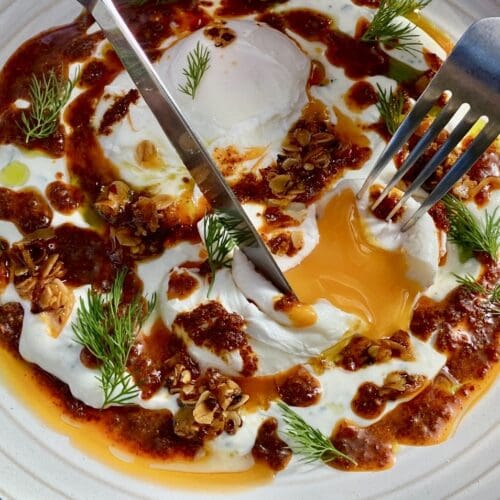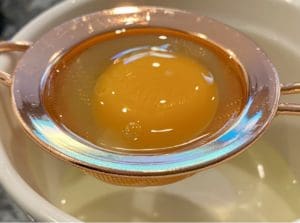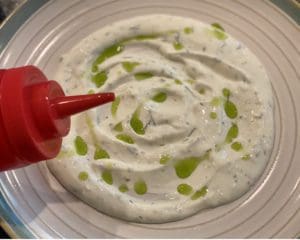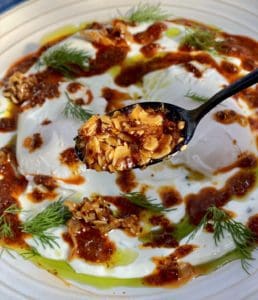
Turkish Eggs
Try these gorgeous Turkish Eggs for a tasty breakfast. Perfectly poached eggs on a bed of garlic yogurt covered in chilli butter sauce!
Ingredients
- 1 cup Greek yogurt (or Turkish yogurt at room temperature) (NOTE 1)
- 1 clove garlic (grated very finely)
- ¼ tsp salt
- 1 tsp finely chopped dill
- salt and pepper to taste
For the chilli butter
- 50 gm unsalted butter
- 3 tsp Aleppo pepper flakes (NOTE 2)
- ⅛ tsp salt (or a pinch)
For the poached eggs
- 4 large eggs
- 4 tsp vinegar
Optional garnish
- dill leaves
- crispy chillies (NOTE 3)
- parsley oil (NOTE 4)
Instructions
- Place the room temperature yogurt into a bowl, then use a microplane to grate the garlic over the yoghurt. Add in the dill and salt, then mix well. Set the yogurt mixture aside for later.

- Brown the butter slowly by melting it in a small frying pan over medium-low heat. It's done when the butter smells nutty and the milk solids (dark bits) have sunk to the bottom. Keep your eyes on it because at this stage, the butter may burn. Remove the butter from the heat and stir in the Aleppo peppers and salt. The mixture will bubble, but this is normal. Leave the pan aside to cool, so the pepper infuses the butter.

- Fill the saucepan 2/3 full with water, or enough to submerge the eggs. Place saucepan over high heat until it boils. Whilst waiting for the water to boil, prepare the eggs. Crack an egg into a small sieve with a small bowl underneath. The runny part of the egg whites will drop through the sieve, doing this will get rid of whites that leave ugly strands when poaching. Transfer the egg from the sieve to a small bowl or teacup, then pour a teaspoon of vinegar straight onto the egg.

- When the water reaches boiling point, reduce the heat to low. Let the water settle, so there's no movement in it, then lower the egg carefully into the water. Poach the egg for 2 to 3 minutes or until whites have set, but the yolks are runny. I recommend poaching two eggs at a time because having too many eggs may cause the temperature of the water to drop, and this may cause the eggs to poach unevenly. Also, on your second batch of eggs, remember to increase the heat and bring the water to a boil again, then reduce it to low before placing the eggs in.

- Divide the yogurt mixture into two and spoon it onto serving plates. Use a spoon to make a round bed for the eggs with the yogurt. Drizzle the parsley oil (if using) on top of the yogurt.

- Remove the eggs out of the water with a strainer and wait until most of the water has dripped from the egg. Carefully lower 2 eggs onto each place on top of the yogurt, then sprinkle the eggs with some salt and pepper to taste. Drizzle with the chilli butter, then garnish with dill and chilli crisps (if using). Serve immediately.

Notes
(NOTE 1) Greek yoghurt - Unfortunately for us, Turkish yogurt it's not widely available over here, so I used plain full cream thick Greek yoghurt.
(NOTE 2) Aleppo pepper flakes are not very spicy, but they add beautiful colour to dishes with lovely smoky and aromatic flavours. I had trouble finding Aleppo pepper (chilli) flakes because they weren't available in supermarkets or specialty shops, so I ordered mine online. The Aleppo pepper I've got is from Turkey but packaged here. If you can't get a hold of these Aleppo peppers, you can substitute with 3 teaspoons of smoked paprika and 1/8 tsp (or a pinch) of cayenne pepper.
(NOTE 3) Crispy chilli (optional) - To add some texture and give the dish an extra spicy kick, I used Krunchilli's crunchy chillies that were gifted to me. You could leave this out, but I highly recommend them if you love heat and texture as we do!
(NOTE 4) Parsley oil (optional) - This is mostly for aesthetic purposes, the beautiful vibrant green parsley oil gives the dish a stunning look. Stay tuned because my next post will be 'how to make homemade parsley oil'.
A Third-Party Application calculated the calories and nutritional information. Please use this as an approximate guide only.
Cooking measurements are in Australian standard spoon and cup measurements.
Nutrition
Serving: 1servingCalories: 396kcalCarbohydrates: 6gProtein: 24gFat: 31gSaturated Fat: 16gPolyunsaturated Fat: 3gMonounsaturated Fat: 9gTrans Fat: 1gCholesterol: 431mgSodium: 686mgPotassium: 350mgFiber: 1gSugar: 4gVitamin A: 2062IUVitamin C: 1mgCalcium: 187mgIron: 2mg